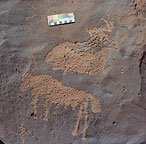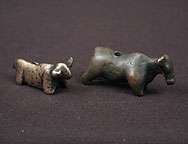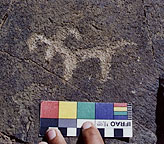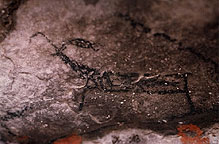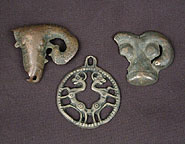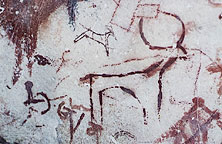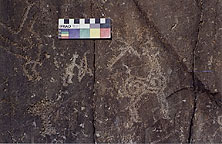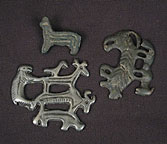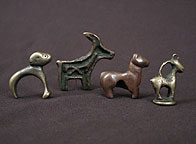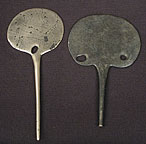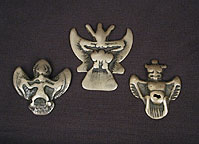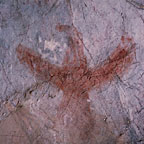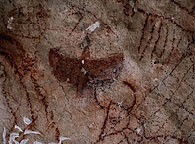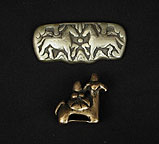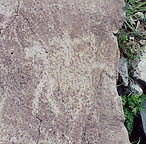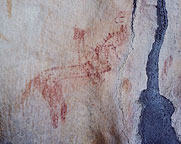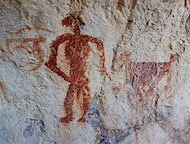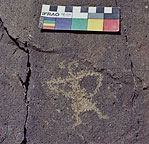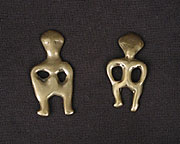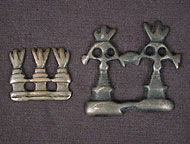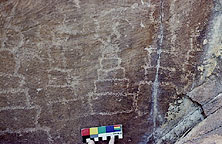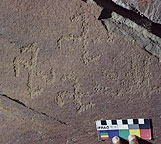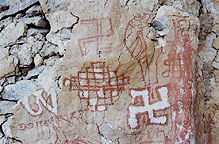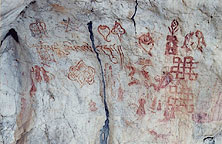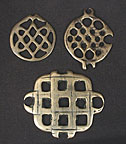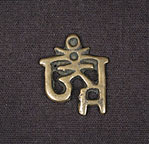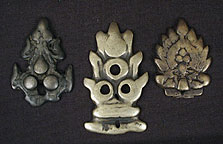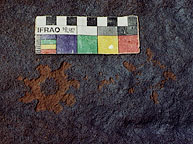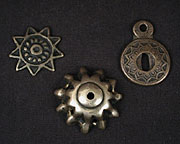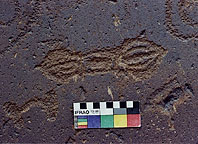asianart.com | articles
Religion, Magic and Protection in the Art of Ancient Tibet
by John Vincent Bellezza
Thokchas illustrated in this article belong to various private collections.
All photographs of Thokchas by Michael Farrell, © Asianart.com
April 29, 2004
(click on the small image for full screen image with captions.)
Introduction
The art of Tibet reaches deep into prehistory. Before the advent of Buddhism in the 7th century A.D., metalworking, painting and carving on stone were already well developed and had assumed a fair degree of refinement. This artistic heritage reflects the sophisticated cultural and religious life of the early Tibetans. Extant examples of this ancient art closely correspond with the rich tapestry of beliefs, traditions and myths set in the pre-Buddhist period, as revealed in later historical accounts and the oral tradition. The representations, narratives and way of life presented in this visual tableau serve to illustrate in broad strokes the character and form of pre-Buddhist civilization in Tibet. There is no more illustrative an indication of early civilization on the Tibetan Plateau than this art.
Buddhist and pre-Buddhist art share many structural (subject matter and execution) and functional (meaning and usage) parallels. This dynamic interplay between the two great artistic traditions, the indigenous and the Indian, is a defining feature of the syncretistic nature of Tibetan culture. Buddhist sculpture and painting adopted earlier technologies and esthetics, developing them in innovative ways to serve the new religion and ethos. The basic media as well as many zoomorphic and symbolic compositions originating in the pre-Buddhist period were readily reinterpreted as Buddhism took root. Seminal motifs such as the swastika, sun and moon, eagles, and wild herbivores were adapted to encapsulate Buddhist tenets and philosophies. This was mainly accomplished with the aim of strengthening and disseminating Buddhism among the Tibetans.
This article focuses on two of the most important artistic media in ancient Tibet: rock art and small metal objects. We will examine petroglyphs (carvings on rock surfaces), pictographs (rock paintings) and copper alloy artifacts known as thokchas, which range in age from deep in the pre-Buddhist period to the first five centuries of Tibetan Buddhism. Despite the cultural and historical significance of these media, they are still not well known to art historians or scholars of Tibet in general. This article in its own small way is designed to help remedy this lacuna in Tibetan studies by making valuable sources of ancient material culture available for inspection.
In addition to rock art and small metallic objects, pre-Buddhist Tibet also produced ornamented metal armaments, horse tackle, stone and metal sculptures, and large burial goods, but these are yet to be well documented. As archaeological research intensifies in the coming years, these other genres of ancient art and technology will come forth as objects of study and exhibition.
Rock art and thokchas are the two best-distributed forms of the art of ancient Tibet. The former is accessible to researchers in scores of rock art theatres located primarily in Upper Tibet, and the latter circulate widely in various private collections built up over the last two decades. Petroglyphs and pictographs have graced rock surfaces for at least 3000 years and thokchas have probably been produced in Tibet for just as long. The chronology of these cultural materials, however, is still highly uncertain as archaeological work on the Plateau remains in its infancy. This general lack of firm dating for ancient art is a major obstacle to our understanding of how Tibet’s civilization blossomed prior to the introduction of Buddhism.
Petroglyphs and pictographs represent the most varied sources of Tibet’s ancient art. More than 70% of this rock art has been discovered in northern and western Tibet, the region generally known as Upper Tibet (Töd and Changthang). This territory more or less conforms to the mighty Zhang Zhung kingdom of pre-Buddhist times, as described in numerous legendary and quasi-historical accounts. Rock art encompasses aboriginal, Bon and Buddhist cultural traditions, three main pillars on which Tibetan civilization rests. A very wide range of symbolic, iconic and narrative motifs is represented in petroglyphs and pictographs. Their study significantly enhances our comprehension of the historical and artistic development of Tibet gleaned from literature and the oral tradition.
Thokcha is a generic term applied to small copper alloy objects of sundry functions and sources, which are used as amulets. The thokchas illustrated in this article vary between 2.5 cm and 8 cm in length. The word thokcha is derived from the Tibetan thog (first, primordial, thunderbolt) and lcags (iron, metal), and therefore can be translated as ‘first metal’ or ‘thunderbolt iron’. According to a popular myth, thokchas were formed when molten thunderbolts struck the ground and interacted with moisture contained therein. Rather than denoting a specific class of artifact, thokchas refer to any copper alloy object that has come to assume talismanic properties. These include items that were specifically designed to be worn as personal amulets and can depict certain deities and religious symbols. Ancient utilitarian articles and implements of war that have assumed a mythic protective status, largely as a result of age, have also come to be called thokchas.
The rock art and thokchas presented in this article are organized to explore the way in which these two artistic media are stylistically, thematically and chronologically interrelated. The juxtaposition of analogous rock art and thokchas in the inventory of images presented here bespeaks the existence from pre-Buddhist times of a largely indigenous artistic tradition. This inborn Tibetan undertaking of creativity and workmanship was expressed in the diverse activities of painting, rock carving and metal casting.
As the inventory of images will confirm, the content and execution of rock art and thokchas are often closely interrelated. We can take these connections to be illustrative of chronological and functional correspondences, which were drawn from a common wellspring of cultural tradition. A variety of possible motives for the creation of rock art and thokchas can be suggested but these remain speculative. Foremost among these hypothetical incentives for artistic expression are the perennial need for protection and sustenance, the reflection of religious beliefs, and the augmentation of personal/collective power and prestige.
By studying the common esthetic links between rock art and thokchas we gain a better appreciation of the ubiquity of ancient Tibetan artistic motifs. This body of ancient art however, must not be viewed monolithically, as it is made up of various strands of myth, belief and convention extending across many centuries and the vast expanse of the Tibetan pleateau.
ChronologyWithout the underpinning of a verifiable chronology, the manner in which rock art and thokchas sprung up over time cannot be elucidated. The term ancient in this article is therefore used as a general label for art and artifacts that vary greatly in age. The precise dating of these cultural materials will continue to elude us until the requisite chronometric data is compiled through systematic and extensive archaeological investigation.
In the inventory of rock art and thokchas that follows, I have employed two descriptive terms to provide some indication of relative age: pre-Buddhist and early Buddhist. In this context, ‘pre-Buddhist’ refers to artifacts made before 620 A.D., and ‘Early Buddhist’ refers to indigenous and Indian-inspired art produced between the 7th century and 1300 A.D. This includes the corpus of native forms that continued to be produced in the imperial period and its aftermath (approximately 620-1000 A.D.), and the art created during and after the second diffusion of Buddhism (1000-1300 A.D.). The non-exact and highly inclusive nature of these two designates is at once apparent, but I believe nonetheless, that it important to attempt a tentative chronological attribution. These attributions can serve as a departure point for further inquiry. The designations pre-Buddhist and early Buddhist as applied in this article are based on inferences drawn from the following types of evidence:
I) Rock Art
a. Relative superimposition of images (palimpsests)
b. Degree of repatination
c. Erosion and wear characteristics
d. Microenvironmental and geochemical modifications of rock surfaces
e. Exfoliation and browning of pigment
f. Cultural and economic orientation
g. Style and design traits
h. Methods and technologies used in manufacture
i. Cross-cultural comparisons
II) Thokchas
a. Type of alloy
b. Patination characteristics
c. Cultural and economic orientation
d. Style and design traits
e. Methods and technologies used in manufacture
f. Cross-cultural comparisons
Catalogue of Images
Image set no. 1: Solitary wild yaks. Yaks in various sytles and attitudes are very common in rock art throughout Upper Tibet. There are also thokchas in the form yaks and yak heads.
| 1a. The single pre-Buddhist yak petroglyph presented
here is in all likelihood the wild variant of the animal (drong),
as indicated by the long belly fringe and bushy tail. The strength
and vigor of the wild yak are admirably expressed in this carving.
1b. The respective anatomical features of these yaks seem to convey a male-female pair. The upper figure with its massive body, prominent withers and long belly fringe has the appearance of a male, while the sleeker companion figure has the form of a female. Produced in the pre-Buddhist period, this petroglyph has undergone a significant degree of repatination. Immediately above the upper yak is what appears to be another horned animal exhibiting a much less developed patina. 1c. The copper alloy thokcha yak on the left with its low-slung belly simulates the long, hairy fringe of the wild yak that we saw in two of the three yak petroglyphs. This highly worn, thin-walled specimen probably dates to the pre-Buddhist period. Its warm patina indicates that it was used as personal ornamentation for many generations. The thokcha on the right contains a small hollow interior. Perhaps dating to early Buddhist times, this figurine has no loop for hanging. Such talismans were ordinarily worn by wrapping cords around them. Cultural historical backgroundThe yak in both its wild and domestic forms was, and still is the most important economic animal for Tibetans. Before the domestication of the yak, roving bands of hunters sustained themselves on the meat, hair and hides of the wild yak. The domestic yaks raised by shepherds (drokpa) provide these same essential commodities, which are widely traded in agrarian regions. But the yak in Tibetan culture is more than a mere livestock animal. Over millennia, yaks have been elevated to the status of deities, as well as cultural symbols of fertility, prosperity and martial prowess. From ancient times male yaks have been closely associated with the territorial gods (yulha), clan gods (rulha) and warrior gods (dralha). The lake goddesses and serpent spirits often assume the guise of the female yak (dri). While we cannot pinpoint the precise function of the petroglyphic and thokcha yaks depicted here, we may probably assume that they are represented with their mundane and supernatural functions entwined. |
Image set no. 2: The animals illustrated here appear to represent the wild sheep of Tibet, which include blue sheep and argali.
| 2a. This pre-Buddhist petroglyph shows an animal
with wide curved horns, adeptly portraying this dominant feature
of the wild sheep. This petroglyph was created by removing the entire
rock surface from the composition to give it a silhouetted form.
2b. This black pigment pictograph dates to the pre-Buddhist or early Buddhist period. Painted with a hyperbolic long body, the species identification of this specimen is ambiguous. 2c. The two wild sheep head amulets are attributed to the pre-Buddhist period. Both specimens have one horn missing due to breakage. For display, these large, thin cast heads were probably mounted on some type of backing. The two heads are powerfully rendered as if they possess a divine quality. The large round eyes of the specimen on the right reinforce this preternatural aura. Although their general appearance and body position is more reminiscent of goats, the pair of short-horned animals contained in the circlet might also portray wild sheep. The loophole definitely identifies this object as having been made for suspension from the body. This thokcha either dates to the pre-Buddhist or early Buddhist period. Cultural historical backgroundThe wild sheep of Upper Tibet have been actively hunted since prehistoric times. Unfortunately, in many areas they are now facing extinction. The argali sheep (nyan) has also long played an important religious role in indigenous Tibetan culture. Mountain deities are thought to manifest in this form, the world’s largest species of sheep. The famous mountain god Nyenchen Thanglha may have been originally named in honor of this divine sheep. Indigenous deities also appear in the form of the blue sheep (nawa). In Tibetan Tunhuang and Bon literature, sacred sheep known as kyib luk and la luk act as protective vehicles for the souls of the deceased, transporting them to the afterlife. In many Bronze Age and Iron Age cultures of Inner Asia (Tibet being no exception), sheep horns are deposited with human burials, probably as magical devices to protect and guide the soul. |
Image set no. 3: Various wild herbivores.
| 3a. This image is dominated by a pictographic composition
of a bowman on foot stalking a horned animal resembling an antelope.
This pre-Buddhist depiction was painted in magenta hued ochre with
a minimum of bold strokes. Surrounding it are other ochre pictographs
and part of a Tibetan mani mantra. Note the smaller animal above
the antelope-like depiction. Also belonging to the pre-Buddhist
period, this pictograph was created using sharp, vibrant lines of
purplish red.
3b. This petroglyph of a hunter with bow and arrow pursuing a wild ungulate is one of the most common subject matters in pre-Buddhist rock art. It was proficiently executed using fairly fine incised lines. Here a lone hunter on foot prepares for the final kill of an exaggeratedly large herbivore. The undulating horns of the animal might identify it as an antelope, highly prized for its flesh. Within the body of the animal is a double volute design, a familiar ornamental trait in northwestern Tibet. 3c. For close stylistic comparison with analogous rock art compositions, refer to the single animal at the top of this image. This probable wild herbivore was cast with deeply cut lines circumscribing the body. The accessory attachment on the reverse side was manufactured by simply brazing two metallic protuberances extending from the body of the animal into a v-shaped loop. The manufacture and modeling of this thokcha indicates that it belongs to the earliest period of the Tibetan metalworking tradition. This may chronologically correspond with either the Bronze Age or early Iron Age of Central Asia. The other two amulets in this image are those of multiple animals, representing an unusual style of thokcha. The specimen on the right (shown sideways) depicts a yak resting on what is probably a tiger with a gaping mouth. The other specimen boasts five animals that appear to include (bottom to top): carnivore with gaping jaws, yak, deer (?), and bird. The animal on the left side of the layered of animals might be representative of a sheep. The significance of compounded animals in this genre of pre-Buddhist or early Buddhist thokchas has been lost. We might conjecture that it had something to do with the hunter-prey relationship and the success of hunting expeditions. 3d. This image features four wild herbivore amulets that were probably produced in pre-Buddhist times. From left to right they can be identified as ram, antelope (?), ram, and ibex (?). The two rams are identified by their short horns that curl around the head. The antelope (?) has a x-like design on its body, not unlike that found in certain rock art depictions. The animal on the far right, with its long horn sweeping over the back, most resembles an ibex. On the base of this figure is an engraved swastika. While ibex compositions do not appear in Tibet, this animal is strongly represented in the rock art of adjoining areas of Ladakh, Spiti and Baltistan. Cultural historical backgroundThe rock art shown here demonstrates that wild herbivores (ridak) were important animals of prey in ancient Tibet. In fact, they have been continually hunted to the present day for their meat, hide, hair, and horns. The thokchas however, also illustrate that the wild herbivores of Tibet functioned as potent talismans. The antelope in particular still discharges protective functions in Tibetan culture. Its horns are used to draw magic diagrams on the ground in order to subdue the earth sovereigns (sadak). The territorial gods known as yulha are also long believed to manifest as antelope, wild sheep and other ungulates. Moreover, wild herbivores are found in the retinues of anthropomorphous yulha as their personal herd animals. These divine entourages are believed to exert a salubrious effect on the domestic flocks of the Tibetans. It is such cultural associations that seem to best explain the role of these animals in the rock art and metal objects of ancient Tibetan. This is especially true of animals portrayed in isolation, in non-hunting contexts. |
4a. The identification of this petroglyph as a deer is unmistakable. There is no other animal in Tibet and the Himalaya with antlers. This well executed pre-Buddhist engraving has elaborate body ornamentation consisting of interconnected volutes. Although deer are now extinct from nearly all areas of Upper Tibet, they occupy a substantial place in many rock art theatres. 4b. These probable pre-Buddhist deer figurines were fabricated as three-dimensional objects with both horns and all four legs. They were molded with prominent loopholes for display on the body. Between the horns of both specimens is a crown of three gems, clearly indicating that these are not ordinary animals but sacred or divine cervine variants. 4c. These unusual artifacts consist of long-stemmed mirror-like objects on which deer were engraved. These engravings very closely match their rock art counterparts in terms of the frank simplicity of the execution. The specimen on the left was made with a large deer and two small wild herbivores (deer?) on one side, while the right specimen has a single deer on both sides of the mirror. The two deer on the darker colored mirror were etched with many fine lines to render the body and antlers. The deer appear to be integral to the objects themselves and not subsequent modifications. These pre-Buddhist artifacts may have been employed in hunting magic rituals as charms to attract deer to the hunters. They may also have been created to pay homage to the deer in rites of celebration. It seems likely that deer in certain rock art compositions fulfilled the same type of cultural functions. Cultural historical backgroundThe white-lipped deer (Cervus albirostris) is an animal with a long and august cultural history in Tibet. It has been heavily hunted for its meat and body parts, and it may have once been domesticated in Tibet. This is suggested by certain petroglyphs showing riders mounted on deer and Tunhuang literary references (circa 800 A.D.) that refer to captive deer. The preeminent role of the deer in Tibetan culture however, is tied to its sacred status. Without obvious economic function, the deer as a hallowed or god-like animal best reflects the solitary depictions under examination. The deer is well known in Tibetan religion as a mount of various divinities (especially female ones). It is also mentioned in Bon literature as the original bringer of good fortune (yang) to human beings. The proponent in this myth of good fortune is a conch deer with long crystal horns, which is captured by a son of the gods and brought to the land of humans for their aid. Deer, especially as effigies, constitute an important class of Bon sacrificial items as well. |
Image set no. 5: Khyung, the horned eagle deity of Tibet.
|
5a. This one-meter tall pictograph portrays in much anatomical detail Tibet’s most popular sacred bird, the khyung. Dating to the Buddhist period (circa 1000-1300?), this figure was painted over a rocky rib conceived of as having the form of a khyung. This highlighting in red ochre of a self-formed khyung in stone was accomplished in order to subdue the local water spirits known as the lu. The pictograph has been subjected to considerable wear and damage. While the head has been destroyed, the wings and two arms grasping a serpent (representing the lu) are largely intact. The matching Vajrapani pictograph and mantra (see image 14a) below the khyung positively identify it as a Buddhist composition. 5b. This red ochre pictograph portrays what appears to be a horned khyung with a wild herbivore above. This painting seems to date to the early Buddhist period. The large tail, outstretched wings, and upturned wing tips of the khyung are reminiscent of thokcha designs, although these do not usually have the long neck shown in this pictographic specimen. The wild sheep-like animal in the composition has an unusual placement in that it is typically the khyung that occupies the highest position in rock art or Buddhist paintings. 5c. These three thokcha khyung probably date to the early Buddhist
period. They are readily recognizable by their horns and fully spread
wings. The khyung is one of the most popular deistic thokcha designs.
The three specimens shown here were manufactured in different copper
alloys and with considerable stylistic variation. Nevertheless,
their distinguishing features are the same as those depicted in
the rock art. The khyung in both its indigenous and Buddhist forms enjoys a highly prominent role in the culture and religion of the Tibetans. It has protective, fortune bestowal, didactic, and mystic functions. In both Bon and Buddhism, the khyung is said to dwell on the peak of the world mountain Ri-rab. The khyung is one of the four protective animals flanking the prayer flag, and it is a primary manifestation of clan, territorial and warrior gods. It is also found in the retinues of many guardian, tantric and tutelary deities. In tantric rites of healing, the khyung functions as a divine healer for a variety of ailments. Furthermore, the khyung acts a metaphor for the philosophical view enshrined in the Dzokchen tradition, a system of advanced mind training. |
Image set no. 6: Tibetan birds of prey.
|
6a. The lines of this pre-Buddhist petroglyph of a bird recall the shape of a swastika. Chiseled with just a single line to represent each part of the body, the precise identity of the bird is not discernable. The outstretched wings of the figure are characteristic of khyung and other raptor compositions. 6b. This red ochre raptor was probably painted in the Buddhist period. The extended wings and splayed tail of the pictograph seem to mark it as a bird of prey however, the straight beak and slender form of the wings might actually distinguish it as a duck or goose. 6c. This deep red ochre raptor pictograph has an ill-defined head and tail, giving it a highly stylized appearance. Painted in the pre-Buddhist or early Buddhist period, it has a distinctive iconic form as is also encountered in certain thokcha depictions. 6d. The two lower specimens are popular khyung thokchas,
dating to the early Buddhist period. Horns aside, their general
form is reflected in rock art raptors. The probable pre-Buddhist
upper specimen, with its pyramidal head and abstract aspect, somewhat
resembles the dark red raptor pictograph (6c). Despite exhibiting
far fewer details than the khyung thokchas, this
amulet has a strong and vibrant outline, a defining trait of analogous
Upper Tibetan rock art motifs as well. While it is virtually impossible to pinpoint the species of the hornless raptors depicted in rock art and thokchas, as a group their dynamic role in Tibetan cultural history is undeniable. In addition to the khyung, the falcon/hawk (tra), lammergeyer (thangkar), vulture (göd), and eagle (lak) conspicuously feature in indigenous mythology and iconography. In Tibetan literature and the oral tradition, sundry indigenous deities and clan totems assume the guise of these birds of prey. The saints of the pre-Buddhist kingdom of Zhang Zhung, as well as certain Buddhist adepts, are recorded in the literature as manifesting as raptors in the discharge of their religious duties and as demonstrations of mystic power. The feathers and wings of raptors were widely used in Bon rituals as magic and protective objects. The masters of rocky mountains, the tsen, favor emanating as falcons/hawks. Moreover, the hawk saliently figures in the appellations of indigenous protective deities. The lammergeyer is another very noteworthy bird in native Tibetan culture and religion. Its miraculous qualities as a celestial deity are first cited in the Tunhuang manuscripts. |
Image set no. 7: Indigenous aquatic life.
|
7a. The red ochre pictograph of a scaleless lake carp was probably painted before 1300 AD and the demise of most Bonpo communities in the eastern Changthang. This pictograph accurately captures the anatomical features of this long-lived species of the great lakes of Upper Tibet. It is situated amid many auspicious symbols created by Bonpo circa 1000 to 1250. 7b. The two thokchas shown here are said by some Tibetan informants to represent fish or tadpoles. What appear to be eyes are visible in both specimens, and they also have fin-like protuberances. The ambiguity of the designs however, precludes positive identification. These two amulets date either to the pre-Buddhist period or early Buddhist times. Cultural historical backgroundFish and tadpoles (as well as scorpions, turtles, etc.) are animals that dwell in the aquatic environments of the Tibetan underworld (og). They are specifically connected with the lu or water spirits, a ubiquitous class of genius loci in Tibet. Fish, frogs and other aquatic life are believed to make up the entourages of the lu queens. This is one reason that during the Buddhist period relatively little fishing and exploitation of Tibet’s lakes took place. The lu and their complementary creatures are intimately attached to notions of fertility, child-rearing, milk production, and other spheres of activity that are traditionally identified with females. In a 12th century Bon history it notes that the first king of Tibet Nyatri, and his three brothers first appeared as a fish, frog, scorpion and tadpole. |
Image set no. 8: Horse bearers of the jewels of good fortune.
|
8a. This rare inscribed plaque dates to pre-Communist times. While its precise age is open to question, this carving presents a completely indigenous version of the lungta, the wind-horse of Tibetan prayer flag. Unlike, the well-known lungta printed on cloth, which usually feature Buddhist motifs and symbols, this plaque presents a superb native form of this good luck-generating device. According to Tibetan tradition, the lungta originated in pre-Buddhist times but this remains difficult to corroborate. The discovery of this plaque in Upper Tibet however, does demonstrate that a fully integral native variant of the lungta was in artistic circulation. On the four corners of the plaque, the names of the warrior gods (dralha) of the lungta are written: khyung, dragon (druk), lion (seng), and tiger (tak). These gods guard the four quarters of the universe and bring their supplicants power, wealth and martial prowess. The wind-horse is shown in its typical aspect prancing in the sky. On the horse’s back are the three jewels of good fortune, which in Buddhist tradition are tantamount to the three foundations of the religion: Buddha, Dharma, Religious Community (Konchok Sum). The wind-horse is flanked by clouds and the sun rises high above it. This bearer of good luck is soaring above the mountains depicted in the carving as three pyramidal shapes. Below the three big mountains are the choppy and wavy lines of water, representing the ocean or one of the large Tibetan lakes. From in between the mountains and water spring up two plants or trees flanking both sides of the wind-horse. Symbolic of all life, the vegetation originates from the commingling of the mountains and water, an ancient mythic theme. In both the oral tradition and Bon literature, there are accounts of male mountains mating with female lakes to engender the various beings of the universe. 8b. The lower thokcha depicts a highly stylized horse with three jewels on its back. Dating to the pre-Buddhist or early Buddhist period, it closely corresponds to the horse in the stone plaque. This is further evidence of an indigenous lungta tradition that developed prior to or independent of Buddhism. The upper specimen, a plaque without any attachment points, is made of yellow bronze (li ser). This specimen can also be attributed to the pre-Buddhist or early Buddhist period. It exhibits horses rendered similarly to the other examples shown. The pair of horses carries something on their back, which may well be jewels. Between these capering horses is a single sphere of unknown function. It might possibly represent the sun. As in the stone plaque, the horses tower above three mountains and what is probably clouds billow overhead. |
Image set no. 9: People and deities on horseback.
|
9a. Pre-Buddhist petroglyphic figure on horseback. This simply but beautifully expressed composition shows what appears to be an anthropomorph mounted on a horse. As with many other such solitary depictions, it is hard to determine if the rider is intended to be human or a deity. 9b. This pre-Buddhist composition evinces various details of the horse and rider. The rider appears to hold the reins of the horse with its right hand while wielding an upright object in the left (a bow?). 9c. Rather than the use of deeply chiseled lines this composition was made by lightly abrading the surface of the rock. It depicts the rider with what appear to be outstretched arms as if performing some athletic feat while on horseback. This southern Tibetan petroglyph (the only one from this region to be featured in this article) was made either in the pre-Buddhist or early Buddhist period. 9d. This handsome pictograph of a horse rearing up with its rider probably dates to the early Buddhist period. The horse was painted with a spotted body, solidly colored rear legs, and well-defined mane and ears. The rider wears a conical hat like those found in the eastern Changthang. Known as an Apahor hat, these were popularly worn by shepherds until the Chinese Communist period. 9e. In this image there are four examples of the horse and rider, a popular thokcha type. The flat cast cup-mold specimen on the bottom left can be confidently assigned to the pre-Buddhist period, while the other three specimens may have been manufactured in the early Buddhist period. All four riders grasp at the reins of their horses. The elongated shape of the head of the equestrian in the upper right specimen might mimic a helmet. Cultural historical backgroundIt is very likely that at least some of these petroglyphic compositions actually portray horses with human riders. They may have been made as social indicators of bravery and military strength, or as celebratory expressions. The symbolism that is conveyed by this genre of amulets is open to question. If indeed some represent real horses and riders, it seems likely that they were made as badges of social affiliation or even as military insignia. Nonetheless, a study of Tibetan cultural history weighs in favor of seeing at least certain rock art compositions, and most or all of the thokchas as expressing a protective religious theme. Rather than ordinary horsemen, the anthropomorphous figures are likely those of deities sitting astride their celestial mounts. Indigenous Tibetan deities are frequently conveyed on the backs of flying horses. Among them are the following familiar divine classes: territorial gods (yulha), warrior gods (dralha) and male guardian deities (pholha). These types of divinities have an especially intimate relationship with human beings as personal protectors, allies in business and war, and ancestral figures. |
Image set no. 10: Figures in an attitude of dance.
|
10a. This pictograph of what appears to be three dancing figures with long robes was probably painted in the early Buddhist period. The regimented position of the arms strongly indicates an attitude of dance or an alternative ceremonial behavior. The dancers have one arm raised. The large dancer on the far left is shown with its right arm akimbo. This more adeptly painted figure may have been created prior to its two companions. Much of the red ochre comprising this anthropomorph has been removed through the localized percolation of water over the painting. The impression conveyed is that these figures represent humans but the large figure on the left could potentially have a divine identity as well. 10b. This is another pictograph of what look to be a group of dancers, which was likely to have been painted in the early Buddhist period. At least three of the four figures have their left arms up and their right arms resting on their hips. The lowest figure and the one on the right seem to wear turbans tied around the back of their heads. The larger (higher status?) upper figure may wear its hair in a topknot. The dancer on the right was superimposed on a wild herbivore that was also painted in red ochre. 10c. This thokcha depicts the same type of figure as is met in the pictographs, except that its legs are bared. The flexing of the legs reinforces the impression that this is a dancer. Whether this represents a male or female, human or deity, cannot be ascertained. Cultural historical backgroundAs with other ancient peoples, Tibetans have a long tradition of dance. In western Tibet, the dance tradition known as shon is traditionally traced to the pre-Buddhist Zhang Zhung kingdom. The shon has a cycle of songs that accompanies it, some of which retain their archaic language and imagery. A number of Tibetan religious rituals also have dance components that serve as an offering to the presiding divinities. |
Image set no. 11: Ithyphallic figures.
|
11a. This pictograph is composed of a standing ithyphallic figure in close proximity to an animal that is goat-like in appearance. There is some question as to whether the two components of the pictograph constitute an integral composition. The symbolism encapsulated in this probable early Buddhist period painting is obscure. The standing man or god with long arms and unmistakable male genitalia alludes to the themes of virility and domination. The man and animal in close quarters seem to speak of fertility and procreation, and could have been created as a fetish for these purposes. 11b. This unique pre-Buddhist thokcha pictures an ithyphallic anthropomorph in what looks to be a meditative aspect. Hands on thighs, his phallus extends to meet his joined feet. It is most plausible that this limns the likeness of a cult deity and not a person. Bon and Buddhist ascetics are known to have occasionally remained without clothes. This figure however, is not easily comparable with historic period iconography of either the Bon or Buddhist religion. Again, this object relays the themes of fecundity and male potency. We might speculate that someone carried it with these preoccupations in mind. |
Image set no. 12: Ancient visages.
|
12a. This exceptional red ochre pictograph is found on the prow of a rocky ridge facing east. It appears that this 50 cm high head was painted in the pre-Buddhist period. The pigment applications have undergone a high degree of exfoliation and browning, which reflect significant age. This particular image has been color enhanced in order to accent the pigment applications in the painting. In actuality, this pictograph is darker in color and much more obscured than what is presented here. In fact, unless the sunlight is just right, this pictograph remains virtually invisible even in close quarters. Unfortunately, some sections of the face have also been obliterated. Yet, the wide flattened eyes, broad nose and part of the mouth are discernable. The strong outline of the head tapers to a fairly narrow chin. Almost certainly, this face is that of a deity and it might betoken the guardian of the locale. Although petroglyphs of faces or masks are widespread in Mongolia and south Siberia, this composition is the only one to surface in Upper Tibet. 12b. These three thokchas of anthropomorphous faces may all date to pre-Buddhist times. The two specimens on the left were made to be displayed by threading a cord through the eyelets. In terms of head shape and facial characteristics, the specimen on the right most closely matches the pictographic head. It appears to have a wrathful mien while the other two heads are more pacific in nature. These thokchas are probably the protective visages of deities. Cultural historical backgroundIn historical times, Tibetans have made a huge variety of masks to be used in religious dances (cham) and as likenesses of deities. These latter objects can frequently be seen fixed to the pillars of chapels. The heads displayed here however, do not readily lend themselves to comparison with these cultural materials. As a result, their religious orientation and function are enigmatic. |
Image set no. 13: Solitary anthropomorphs with diamond-shaped heads.
|
13a. This pre-Buddhist petroglyph of an anthropomorph has a number of idiosyncratic features. These include a diamond-shaped head, both arms held akimbo, short legs with feet pointing outwards, and a triangular torso. Found in isolation there is no accompanying symbolism that might help in the identification or interpretation of this figure. 13b. These thokcha anthropomorphs have similarly-shaped heads, legs, outward pointing feet, and arms held akimbo. These copper alloy amulets are attributed to the pre-Buddhist or early Buddhist period. They are reminiscent of personal guardian spirits such as the pholha, which are depicted on wood blocks (par shing) used to make dough and print figures of deities for various rituals. If indeed these metallic objects are functionally related to the petroglyph, it suggests that the stone carving is a rendition of a protective deity or charm. Even if the respective figures are not closely related, they nonetheless demonstrate how cognate forms developed in the diverse media of metal casting and rock carving. |
|
14a. This red ochre rock painting of the popular Buddhist deity Vajrapani (Chagna Dorje) is found as part of a composition with an overarching khyung (see image no. 5a). Cultural historical indications are that it was painted between 1000-1300, during the definitive spread of Buddhism in the southeastern Changthang. Like the khyung above it, it was created with water spirit (lu) suppressing qualities in mind. According to the Bon tradition, this particular locale is inhabited by lu, which are part of their mother tantra tradition (Magyud). This pictograph points to a religious stratagem used by the Buddhists to wrest control of the land from the Bonpo and their deities. Unfortunately, much of the figure has been effaced precluding a complete analysis of its iconographic makeup. The composition is positively identified by the inscription written directly below it in the same red ochre; it reads: ‘Om badzra pani hum’. The stout body of Vajrapani is still recognizable, as well as part of his tiger-skin loincloth and anklets. The corpse he is astride and the flames surrounding him, standard iconographic components, are also visible. This Vajrapani is contained within an oval frame and stands on a lotus base (not shown in image). 14b. These thokcha Vajrapani figures exhibit some of the same specific iconographic traits as the pictograph. This confirms that parallel development in art between the two media of rock art and small object metal casting continued well into the Buddhist period. The two thokcha figures on the right may date to the early Buddhist period while the specimen on the left may be somewhat later (circa 1500?). |
Image set no. 15: Early Bon shrines and associated motifs.
|
15a. This extremely consequential petroglyphic panel exhibits an integrated array of Bon symbols (for a more comprehensive view of this panel see Images of Lost Civilization at asianart.com). From top to bottom, the elements of the panel include: sun, counterclockwise swastika, crescent moon, a pair of Bon shrines, khyung, figure with ornithic traits, tree or plant (right edge), tree or standard (center left), and anthropomorph with a three-pronged crown or feathers. These carvings were either made in the pre-Buddhist or early Buddhist period. These indigenous religious symbols are ordered in a vertical hierarchy, reflecting the orientation of the Bon cosmos into three layers (sipa sum). At the top of the rock slab the sun and moon, two main components of the Bon cosmos, flank the cosmogonic swastika (see Image set 18). In Tibetan culture, the sun and moon often symbolize the female and male elements respectively. Below these is a pair of objects that has the appearance of Bon shrines. They comprise slender pyramidal forms that rest on small square bases. The structures are crowned by prominent trident-like finials. They appear to be an early form of a Bon tabernacle or deity support receptacle of the lhatsug, tenkhar or sekhar class. Their placement near the top of the narrative scene suggests that they are cosmological vessels or models as well. In Tibetan religion, living beings and the universe are described by the metaphor, ‘the contents (cud) and vessel (nöd)’. The large khyung in the center of the image is depicted in typical fashion with horns and fully spread wings. To its right is a figure with a three-pronged crown (perhaps feathers or crown), a pointed beak and bird-like arms. Such a figure could be a deity or human adept; both are known to assume avian forms in the Bon tradition. Flanking the lower part of the khyung is a tree or plant symbol (left) and what could either be a tree or object of some type (such as a standard or other ritual implement). At the bottom of the image is an anthropomorph with a distinctive headdress of three points. This of course is reminiscent of the Bon crown known as the ‘horns of the bird’ (charu). It may be that the khyung, ornithic figure and anthropomorph form three stages in a genealogical origination myth. The khyung is the clan symbol of the Se-khyung clan, which hailed from the ancient kingdom of Zhang Zhung (this rock art is found in what was a Zhang Zhung region). The transition from fully avian to human in the three figures may register the theogony of the Se-khyung clan and its descent from the celestial realm (lha yul) to the earth (mi yul). 15b. These thokchas also depict early variants of Bon shrines, and were cast not later than 1200, if not considerably earlier. The trio of shrines on the left consists of five tiers resting on a thin base. In the Bon tradition, these graduated tiers symbolize the five elements (space, air, fire, water, and earth) that compose the universe. These stepped structures are topped by three long points, which in Bon are referred to as, ‘the horns of the bird, the sword of the bird’ (charu chatri). This finial symbolizes the superlative nature of the Bon religion and its heavenly origin. The pair of shrines on the right bears a remarkable resemblance to the petroglyphic shrines in image 15a. It is highly unlikely that they share the same structural elements out of coincidence, and we can infer that these objects are functionally and chronologically interrelated. While we can be confident that the petroglyphic and copper alloy objects simulate tabernacles and/or cosmological symbols, their exact cultural basis and application have been lost to time. |
Image set no. 16: Early tabernacles and stupas.
|
16a. This pre-Buddhist or early Buddhist petroglyphic shrine may be a precursor of the Indian stupa (chorten), or an entirely different class of religious monument. It consists of four graduated tiers supporting a rounded upper element. 16b. An early Bon stupa, circa 650-1000. Note the counterclockwise swastika on its left. It is comprised of seven variable-sized rectangular steps (pang rim). On the lower tiers are curvilinear etchings of unknown identity. Upon the seven-tier base is a small bulbous section (bumpa). It is surmounted by a flanged element and a horn-like finial. 16c. The thokcha specimen on the left is directly comparable with the four-tiered shrine in image 16a. Its dates to pre-Buddhist or early Buddhist times. The specimen on the right is clearly that of a stupa. Its large slightly tapering base, squat bumpa and broad pyramidal spire (khorlo) are structural features of Khadampa style stupas built in Tibet from 1000 onwards. The design of this specimen is more in keeping with contemporary conceptions of stupa construction than the Bon variant in image 16b. 16d. Three more thokchas depicting stupas of various types.
The specimen on the left with its triple gem finial enveloped by
a scrolled banner appears to date to the early Buddhist period.
The middle specimen is that of a buckle used to bind stacks of scriptures.
The eight stupas decorating it are attributable to the Buddhists.
This object may have also been produced in the early Buddhist period.
The thokcha on the right seems to portray a rudimentary
type of stupa dominated by a graduated base and small upper section.
If the bullet-shaped protuberances above the stupa are, in fact,
the two highly worn ends of a vajra, it would demonstrate
that this style of stupa was also used by the Buddhists. The stupa symbolizes the processes leading to liberation as well as the qualities of Buddhahood. Stupas are also erected as cosmological symbols, reliquaries, and to subdue inimical influences and spirits harboring in the earth. The Indian Buddhist stupa reached Tibet no later than the first diffusion of Buddhism in the 7th to 9th centuries. With certain modifications (such as the bird horn finial) it came to be widely adopted by the Bonpo. The Bonpo maintain however, that the stupa was in use by them in pre-Buddhist times. We must therefore consider the possibility that it was introduced from locations such as Gandhara into Tibet prior the 7th century. Petroglyphs of Gandharan-inspired stupas found in Indus Kohistan could well indicate a vector of geographic transmission into western Tibet. Petroglyph image 16a and the metallic specimen on the right in image 16c document the existence of a pre-Buddhist or early Buddhist period religious monument, which has completely disappeared in the later architecture of Tibet. The only possible exception is the construction of stepped tabernacles in special Bon liturgical practices. If these types of ancient structures are indeed related to modern Bon variants, they can be identified as tenkhar or sekhar, shrines of varying degrees of complexity, which are erected for indigenous deities. They function to comfortably house divinities while they are the focus of propitiatory rituals. |
Image set no. 17: More types of early stupas.
|
17a. This pictograph of a five-tiered shrine with a spherical top could either be a primitive form of the stupa or an alternative type of early Bon shrine. The vowel signs of a Buddhist mantra were superimposed on the bottom of the painting at a later date. It is not known if such pictographic compositions existed in the pre-Buddhist period or if they arose in the subsequent early Buddhist period. 17b. This pictograph of a rather elementary stupa has a base of five graduated tiers, round bumpa, and a simple stem as the upper element. Probably dating to the early Buddhist period, it cannot be determined if this is a Bon or Buddhist example of the monument. At this juncture, we simply do not know enough about the archaeology and historical development of early shrines and stupas to positively identify or accurately date them. 17c. These elementary stupa-like petroglyphs have simple multilevel bases and large horn-like finials. They date circa 650-1000. 17d. Analogous types of tabernacles and shrines are found in thokcha art as well. In this particular genre they occur resting between the horns of sheep. It would seem that they were manufactured during the early Buddhist period, but it cannot be fully discounted that certain ones among them may actually predate Buddhism in Tibet. The uppermost specimen bears the strongest likeness to the petroglyph in image 17a. The dark patinated specimen on the right has the three-pointed crown of Bon inspiration. The specimens on the left and bottom of the image also appear to model shrines that are archaic in form. The sheep heads have the anatomical character of the domestic animal. Sheep heads (particularly the wild animal) are still used as offerings on shrines for indigenous deities. This custom might allude to the function of the sheep heads in this group of thokchas as an offering article or divine symbol. |
|
18a. This group of three counterclockwise swastikas appears to date to the pre-Buddhist period. They face in the characteristic Bon direction. The swastika is the most common symbol represented in the rock art of Tibet. 18b. The framed Bon swastika on the left may have originally been used as a buckle for tying unbound stacks of Tibet scriptures. It dates to the early Buddhist period. The clockwise swastika is a Buddhist object. It has a large ring on the reverse side for attachment. It was possibly used as a political or military badge. This object may postdate the early Buddhist period. Cultural historical backgroundIn Bon, the swastika is foremost cosmogonic in nature, a symbol of the origination of the universe. In Tibetan, the swastika is called yung drung, which means unborn and undying, a mark of eternity and absolute stability. According to Bon tradition, it has been used in Tibet since time immemorial. Widely represented in Bon and Buddhist art, the swastika also has esoteric significance in tantra and meditational practices. In Tibetan folk culture, the swastika is one of the best-known signs of good luck, and is incorporated in many types of articles. |
Image set no. 19: Auspicious symbols. All the symbols shown here have protective, good fortune-granting and sundry doctrinal functions. Again, we see how the contents and figuration of rock art and metallic amulets mirror one another.
|
19a. These auspicious symbols were painted on the exterior wall of a Bon Dzokchen hermitage, Ngari province. This retreat center was in active use prior to 1300 and the eviction/conversion of the Bonpo. Painted in red ochre and a white pigment, the symbols include the letter A, two counterclockwise swastikas, an ‘endless knot’ (pata), and a conch (dungkar). 19b. The cave wall shown here is replete with red ochre Bon motifs painted prior to 1300. The panel likewise includes three ‘endless knots’ and two conches (the fish in image 7a, and dancers in image 10a are also visible). The various auspicious symbols and other representations surround the famous Bon mantra, ‘Om matri muye sale du’. In addition to those already noted, there is a parasol (uduk), five-pointed star, ‘flaming jewels’ motif (norbu member) vase (bumpa), as well as human and animal figures on the panel. These auspicious symbols are not depicted in the standard Buddhist manner, a set of eight symbols known as tashi dargye. This indicates that they comprise either a prototypical or heterodox rendition. 19c. Three thokcha ‘endless knot’ designs, symbols of infinity. The smaller two specimens are attributed the early Buddhist period, the larger one may be somewhat more recent. 19d. A thokcha Om syllable. This talisman can probably be assigned to the early Buddhist period. As exemplified by the double vowel sign, the syllable is either part of the Bon tradition or an early Buddhist orthographic variation The syllable Om has vast esoteric implications in Bon and Buddhism. Its signification includes the acoustic origin of the universe, a symbol of the primal nature of the Buddha, and a meditational seed syllable, among other diverse meanings. |
Image set no. 20: ‘Flaming jewels’, a divine attribute symbolizing gnostic transformation, spiritual power and supraliminal knowledge.
|
20a. This unusual red ochre composition appears to be a ‘flaming jewels’ (norbu membar) symbol. It was probably created before 1300 A.D. and the disappearance of the Bonpo from most parts of the southeast Changthang. Like many of the Bon symbols we have already encountered, this depiction is at variance with more recent Buddhist design conventions. The pair of spirals and the pair of circles near the base of the painting seems to represent jewels and the seven points, flames. The ‘flaming jewels’ motif however typically has three jewels, not four. Alternatively, this enigmatic composition could possibly be a torma, a diverse class of sacrificial offerings. Like this painting, some torma have multiple points or peaks. 20b. These thokchas are unmistakably ‘flaming jewels’ motifs. Whether they were made for the Bonpo or Buddhists is not ascertainable. |
Image set no. 21: Sunbursts, symbols of light and life.
|
21a. This sunburst with seven rays is assigned to the pre-Buddhist period. 21b. These circular amulets with symmetrically arranged points appear to be sun symbols (or alternatively, flowers). They can be assigned to the pre-Buddhist or early Buddhist period. The specimen on the left reflects Bon numerological reckonings. It has nine outer points and thirteen inner dots. Both of these numbers figure prominently in Bon cosmological and doctrinal traditions. The lower specimen with its eleven points may also be a solar symbol. The thokcha on the right has thirteen rays or petals arrayed across the disc. This design is reminiscent of lotus petals. On the basis of its numerical ordering it is attributable to the Bonpo. |
Image set no. 22: The vajra, thunderbolt symbol of the adamantine nature of tantric Buddhism. This examination of the vajra in rock art and in objects of personal protection will serve to conclude this presentation. The vajra best exemplifies the Tibetan Buddhist tradition, which came to embellish or supersede many of the indigenous religious and artistic traditions explored in this article.
|
22a. Petroglyphic vajra probably from the early Buddhist period. The fairly advanced patina that has accumulated on the carving is an indication of substantial age. 22b. These vajras (known as dorje in Tibetan) constitute the most widespread design in thokchas. The popularity of the vajra is explained by the fact that it is tantric Buddhism’s hallmark symbol. The specimen on the extreme right belongs to the early Buddhist period, the other three specimens may have been cast at a later date. |
Contents Credits:
All images of rock art ©1995-2003, John Vincent Bellezza
Thokchas illustrated in this article belong to various private
collections.
All photographs of Thokchas by Michael Farrell, © Asianart.com
For more information on rock art and thokchas by the
author see:
2004 (Forthcoming). Himalayanart.com website
2004 (Forthcoming). THDL.com (Tibet Himalayan Digital Library) website.
2004 (Forthcoming). Calling Down the Gods: Spirit Mediums, Sacred Mountains and the Bon Tradition in Upper Tibet.
2003. “Bringing to Light the Forgotten: Major Findings of a Comprehensive
Inventory of Pre-Buddhist Sites in Upper Tibet (Tibet Autonomous Region,
Peoples Republic of China).
Conducted Between 1992-2002” in Westport: Athena Review 3 (4).
2002. “Gods, Hunting and Society: Animals in the Ancient Cave Paintings of Celestial Lake in Northern Tibet” in Rome: East and West 52 (1-4), 347-396.
2002. Antiquities of Upper Tibet: An Inventory of Pre-Buddhist Archaeological Sites on the High Plateau, Delhi: Adroit.
2001. Antiquities of Northern Tibet: Archaeological Discoveries on
the High Plateau, Delhi: Adroit.
2000. “Bon Rock Paintings at gNam mtsho: Glimpses of the Ancient
Religion of Northern Tibet” in Melbourne: Rock Art Research
17 (1), 35-55.
2000. “Images of Lost Civilization: The Ancient Rock Art of Upper Tibet” in Asian Art Online Journal, http://www.asianart.com/articles/rockart/index.html
1999. “Northern Tibet Exploration: Archaeological Discoveries of the Changthang Circuit Expedition” in Asian Art Online Journal, https://www.asianart.com/articles/tibarcheo/index.html
1999. “The Ancient Amulets of Tibet”, in Asian Art Online Journal, https://www.asianart.com/articles/tibarcheo/index.html
1998. “thogchags: Talismans of Tibet” in Hong Kong: Arts of Asia 28 (3).
1997. Divine Dyads: Ancient Civilization in Tibet, Delhi: LTWA.
1997. “Notes on Three Series of Unusual Symbols Discovered on the Byang thang” in Rome: East and West 47 (1-4), 395-405.
1994. “thog lcags” in Delhi: The Tibet Journal 19 (1), 92-97.

